Numbers | Term 1 Chapter 1 | 6th Maths - Estimation of numbers | 6th Maths : Term 1 Unit 1 : Numbers
Chapter: 6th Maths : Term 1 Unit 1 : Numbers
Estimation of numbers
Estimation
of numbers
ŌŚÅ Nearly 60,000 people watched the Republic day
parade at Rajpath, New Delhi.
ŌŚÅ About 2,80,000 people of various countries died
due to earthquake and Tsunami on 26th December 2004 in the Indian ocean.
ŌŚÅ The India-Pakistan cricket match was viewed by
about 30 million cricket fans in the Television all over the world.

We often come across statements like these in TV
channels and dailies. Do these news items, give the exact numbers? No. The numbers
mentioned are not accurate. They are only the approximate or closer values to the
actual ones. This is the reason, why we generally use words like ŌĆ£aboutŌĆØ, ŌĆ£nearlyŌĆØ
and ŌĆ£approximatelyŌĆØ. These numbers are only the estimation of the actual value.
The word ŌĆśaboutŌĆÖ denotes the number not exactly, but a little more or less. This
value is called the estimated value.
The actual figure, though not exactly possible,
could have been 59,853 or 61,142 for the first example, and it could have been 2,78,955
or 2,80,984 for the second example. Imagine and write about, what could have been
the exact number for the third example given above? Similarly, there are many more
possible numbers. Thus,
ŌŚÅ to get a rough idea we need estimation.
ŌŚÅ to get the estimated value, we generally round off
the numbers to their nearest tens, hundreds or thousands.
Some real life situations where we use estimates
are
(a) Cost of a Television,
Refrigerator, Mixer Grinder etc., is usually expressed in thousands of rupees.
(b) The Voters population
in an Assembly Constituency in a state is often stated in lakhs.
(c) The Central or State GovernmentŌĆÖs Annual Budget
is usually given in lakh crore.
When an exact answer is not necessary, estimation
strategies can be used to determine a reasonably close answer.
Activity
1. Fill
up the jar with some items like Tamarind seeds. Let each student give an estimate
of the number of items. Make a table of the result by finding the difference of
the estimate and the actual amount.
2. Get a large jar and a bag of Tamarind
seeds and put 30 seeds in the jar. Observing the contents, estimate how many seeds
roughly will fill the whole jar. Continue to fill the jar to check your estimate.
Rounding off is one way to find a number for estimation
that is quite convenient. It gives us the closest
suitable number according to a given place value. There are four steps involved
in the rounding process. Let us illustrate this with an example.
Example 1.11
Round off the number 8,436 to the nearest hundreds.
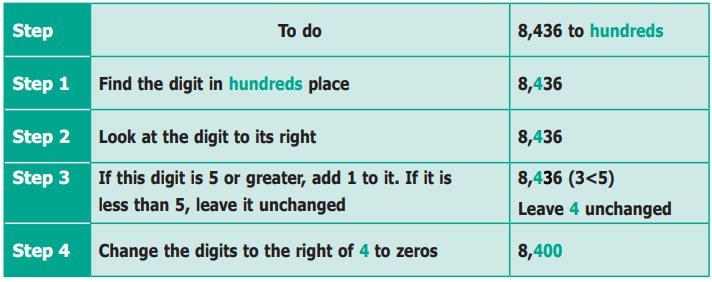
Example 1.12
Round off the number 78,794 to the nearest thousands.
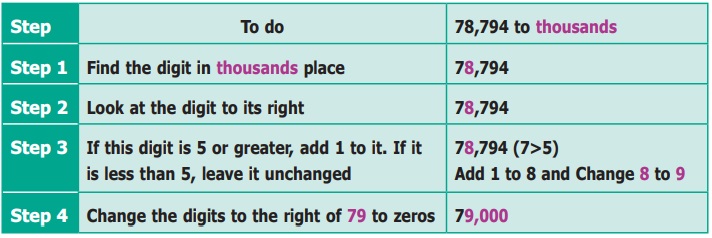
Try these
ŌŚÅ Round off the following numbers to
the nearest ten.
(i) 57 (ii) 189 (iii) 3,956 (iv) 57,312
Solution:
(i) 57 = 7 > 5 ŌåÆ 60
(ii) 189 = 9 > 5 ŌåÆ 190
(iii) 3,956 = 6
> 5 ŌåÆ 3,960
(iv) 57,312 = 2
< 5 ŌåÆ 57,310
ŌŚÅ Round off the following numbers to
the nearest ten, hundred and thousand.
(i) 9,34,678 (ii) 73,43,489 (iii) 17,98,45,673
Solution:
Nearest ten
(i) 9,34,678 = 8 > 5 ŌłÆ> 9,34,680
(ii) 73,43,489 = 9 > 5 ŌłÆ> 73,43,490
(iii) 17,98,45,673 = 3 < 5 ŌłÆ> 17,98,45,670
Nearest hundred
(i) 9,34,678 = 7 > 5 ŌłÆ> 9,34,700
(ii) 73,43,489 = 8 > 5 ŌłÆ> 73,43,500
(iii) 17,98,45,673 = 7 > 5 ŌłÆ> 17,98,45,700
Nearest thousand
(i) 9,34,678 = 6 > 5 ŌłÆ> 9,35,000
(ii) 73,43,489 = 4
< 5 ŌłÆ> 73,43,000
(iii) 17,98,45,673
= 6 > 5 ŌłÆ> 17,98,46,000
ŌŚÅ The tallest mountain in the world
Mount Everest, located in Nepal is 8,848
m high.
Its height can be rounded to the nearest
thousand as __________.
Answer: 9000
1. Estimation of Sum and Difference
Example 1.13
The amount deposited by a Gold merchant in his bank
account in the month of January is Ōé╣17,53,740 and in the month of February is Ōé╣15,34,300.
Estimate the sum and difference of the amount deposited to the nearest thousand.
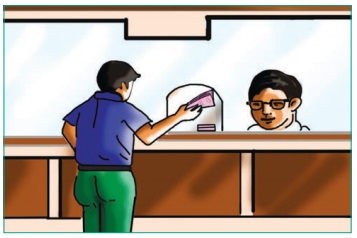
Solution
Rounding off to the nearest thousand is as follows.
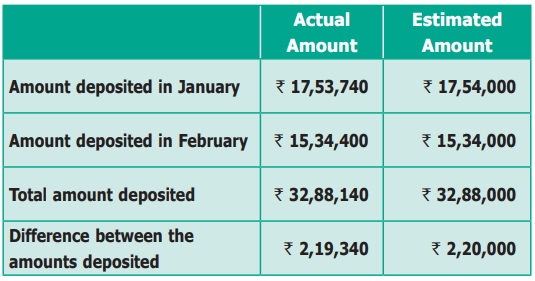
Think
Is 2,19,340 is rounded off to its nearest thousand as 2,20,000. Why?
2. Estimation of Product and Quotient
Example 1.14
If the cost of a copy
of a Thirukkural book is Ōé╣ 188,
then find the estimated cost of 31 copies of such books. (Note: Find the rounded
values of 188 and 31 and then find the result)
Solution
Here, 188 is nearer to 200 and 31 is nearer to 30.
The exact cost of 31 copies is 188 ├Ś 31 = Ōé╣ 5828 whereas,
The estimated cost of 31 copies = 200 ├Ś 30 = Ōé╣ 6000
Therefore, the estimated cost of 31 copies of Thirukkural
books is Ōé╣ 6000.
Example 1.15
Find the estimated value of 5598 ├Ę 689.
Solution
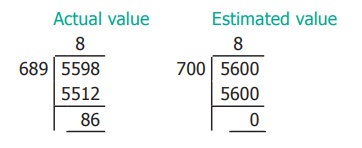
5600 is nearest to 5598
700 is nearest to 689
Hence, the estimated value of 5598 ├Ę 689 is 8
Try these
ŌŚÅ Estimate
the sum and the difference : 8457 and 4573.
Solution:
Actual sum = 8457
= 4573
13030
8457 + 4573 = 13030
Estimate sum =
8000
(Nearest to thousand) = 5000
13000
Hence the estimated sum of 8457 + 4573 = 13,000
Actual difference : 8457 ŌłÆ 4573 = ?
8457
4573
3884
8457 ŌłÆ 4573 = 3884
Estimated difference = 8000 ŌłÆ 5000
(Nearest to thousand) = 3000
Hence the estimated difference between 8457 and 4573 is 3000.
ŌŚÅ Estimate
the product: 39 ├Ś 53
Solution:

39 ├Ś 53 = 2067
Estimated product = 40 ├Ś 50
(Nearest to ten) = 2000
Hence the estimated value of 39 ├Ś 53 = 2000
ŌŚÅ Estimate the quotient: 5546 ├Ę 524
Solution:
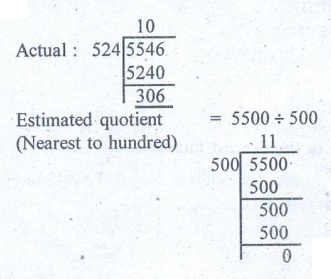
Hence Estimated quotient of 5546 ├Ę 524 = 11
Related Topics